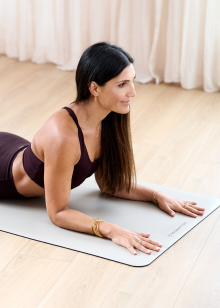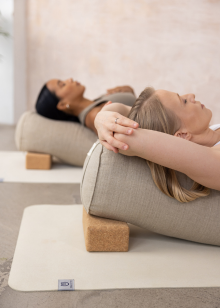It’s magical to see the yoga community working together to deliver live yoga classes online and into our homes when the world needs it the most. But for Yoga Teachers and Yoga Studios it can feel like a daunting step to dive into such unknown territory – the world of virtual yoga classes. We’ve compiled some simple steps for teachers and studios to help you bring classes to your students wherever they are in the world.
Technicalities of Zoom
Zoom has been a very popular choice for live classes over the past week, it works so well because teachers can see all participants, invite via email with a simple link and control who joins the class. Here are some simple steps to setting up your account.
- Set-up account an account via Zoom – a free account will only allow 40 min video. The Pro account is £11.99 per month and is great for teachers, the Business account is £15.99 and is perfect for studios who want to brand the experience for customers and branch to wider audiences via your domain.
- Once you have chosen your account type, visit the ‘meetings tab’ within your dashboard to start adding your classes and attendees in.
- When setting up your classes using the options you will see the option to add a waitroom. This allows you to control who can come into the class and students can only enter when approved. This is great for teachers and studios that are offering a paid for class.
- The teacher is able to see up to 49 participants in Gallery View. Seeing the students can give a similar feel to a studio class and add a personal element to both the teacher and students experience.
Inviting students
- The great thing about Zoom is that students do not require an account to join the meeting; they can access your class via just a link on their mobile, tablet or desktop.
- You can invite people by calendar or email – you can also copy the link and send them the link on any platform you like such as WhatsApp, Facebook etc.
- When students first open the meeting they must select to use computer audio
Tips for teachers running classes on behalf of a studio
- If studios are creating a link on behalf of teachers, teachers need to ensure they join the correct meeting that has been created instead of creating a new meeting where the students will not be attending.
- There is an option to lock the meeting to ensure late comers do not land in after the warm up and if there is a class coming up after – early birds do not enter the end of the class!
Setting up your space before the class
- Set out two stations to teach the class. One where you will be talking, guiding mediations, pranayama etc and the other where you can position your mat and demonstrate. Try both out before the class starts. Funnily enough, Zoom tends to zoom in so give yourself excess space to avoid cutting your head off in standing poses.
- If you feel uneasy about the technical side of Zoom try hosting a test run for friends or students for free
- Run an audio test before the class starts
- Click on the arrow next to the mute icon to open the Audio options.
- Select Test Computer Audio.
- Click on Test Speaker to test your speakers (whether external or via headset)
- Click on Test Mic to test your microphone (whether external or via headset)
- Once you have completed the testing, close the window
During the class
- It is advised to mute others during the class so your voice is clearer and any sounds from attendees homes do not disturb the class.
- It is common for Zoom to have a slight delay to real time, so expect to go slightly slower
- Playing music on another system isn’t likely to work because of the audio interference – a Spotify playlist can either be sent via the notes on Zoom or to attendees before the class begins – this will mean everyone needs to be muted
- It is a great idea to wear wireless headphones if you are teaching the class. These come with a built in speaker which is going to stay close to your mouth than the device you are using.
Payment options and other channels to use
If you already have a booking system as a teacher or a studio such as MindBody, Teamup etc. you can continue with the original class booking and perhaps amend the amount due for each class. Once you have a list of those booked on you can email out invites via Zoom.
Paypal
It is also an option to use Paypal for donations if you are streaming on IGTV or Facebook live. Simply set-up an account if you don’t have one already, another option is to ask those contributing to select ‘paying friend’ so you don’t get stung by commission – students are your friends after all!
Facebook paywall
Facebook also allows you to create a paywall on a Facebook Group that requires students to make a payment before accessing the group.
Bank transfer
Another option is to offer your students passes with a number of classes and ask them to transfer the money into your bank account.
Donation based
For studios offering classes there is an option in Mindbody to create payment via donation with a minimum donation and a number of tiers. Donation based classes can also work on any of the above systems too.














